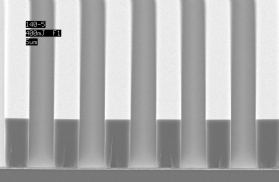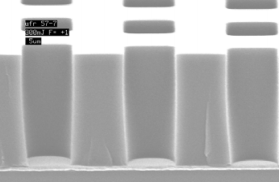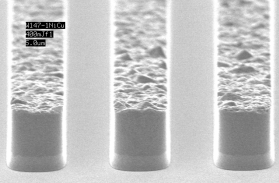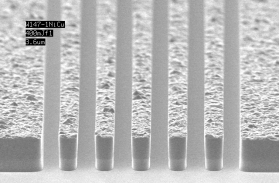AZ 15nXT Photoresist (115cps) - 3.785 l












Product information "AZ 15nXT Photoresist (115cps) - 3.785 l"
AZ® 15nXT (115CPS)
Thick Negative Resist for Plating
General Information
The i-line sensitive negative resist AZ® 15nXT (115CPS) is a thick resist with approx. 3 - 5 µm film thickness and very steep resist sidewalls for e. g. RIE or electroplating, for example.

5 µm lines at 10 µm resist film thickness.

5 µm holes at 10 µm resist film thickness.

5 µm plated CuNi image.

3.6 µm plated CuNi image.
Product Features
AZ® 15nXT (115CPS) covers a resist film thickness range of - depending on the spin speed - approx. 2 - 3 µm. It is only i-line sensitive and requires a post exposure bake after exposure to complete the cross-linking induced during exposure. The resist structures developed are very vertical with adjusted process parameters, becoming increasingly negative towards thick resist films or - based on the respective resist film thickness - lower exposure doses. If thinner resist films are required, the AZ® 15nXT (115CPS) can be diluted with PGMEA = AZ® EBR Solvent; for thicker layers, the higher viscosity AZ® 15nXT (450CPS) is recommended. AZ® 15nXT (115CPS) is suitable as a mask for the galvanic deposition of e.g. Cu, Ni or Au due to its good adhesion to all common substrate materials and its high chemical stability.
Developers
For the development of the AZ® 15nXT (115CPS), TMAH-based developers such as the ready-to-use AZ® 326 MIF (immersion development), AZ® 726 MIF (puddle development) or AZ® 2026 MIF are recommended, which promotes residue-free development, especially with cross-linking resists, thanks to an additive. KOH- or NaOH-based developers such as the AZ® 400 K or AZ® 351B are generally not suitable for the AZ® 15nXT (115CPS). If TMAH-based developers cannot be used, an attempt with a KOH-based developer in higher concentration than usual can be considered.
Removers
If the resist structures have not been thermally cross-linked too much, for example through metallization, stripping or lift-off with organic solvents (acetone rinsed with isopropanol or DMSO) can be successful. For more strongly cross-linked resist structures, high-performance strippers such as the NMP-free TechniStrip NI555 or AZ® 910 Remover are recommended, or in the case of alkaline-sensitive substrate materials (such as aluminum), the TechniStrip MLO 07.
Thinning/ Edge Wall Removal
If the resist is to be diluted for spin coating, PGMEA = AZ® EBR Solvent is an option. PGMEA is the solvent for AZ® 15nXT (115CPS) anyway and is also recommended for edge wall removal if necessary.
Further Information
Our safety data sheets and some of our technical data sheets are password-protected.
You will receive the access data after completing the form.
The access data for the data sheets are not your login data from our shop!
MSDS:
Safety Data Sheet AZ® 15nXT (115CPS) Photoresist english
Safety Data Sheet AZ® 15nXT (115CPS) Photoresist german
TDS:
Technical Data Sheet AZ® 15nXT (115CPS) Photoresist english
Technical Data Sheet AZ® 15nXT Series english
Application Notes:
Further Information about Photoresist Processing
Related products
Developer
Remover


























